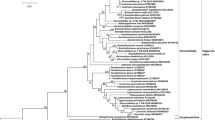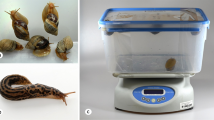Abstract
The systematics of the Ostertagiinae is unsettled with no agreement on how many genera and species are present in cattle and sheep. Ten species of Ostertagiinae are commonly parasitic in cattle and sheep. In the global fauna, six of 13 ostertagiine genera are endemic to Iran. The life cycle of Ostertaginae is direct and ingested third-stage larvae after exsheatment in the rumen, penetrate the gastric glands in the abomasal mucosa where two parasitic moults occur before the L5 emerges from the gland. In the present work, Marshallagia marshalli and Ostertagia occidentalis, collected from the abomasums of sheep from Mashhad, Iran, is described. The association of light and scanning electron microscopy (SEM) allowed a detailed analysis of the morphology and ultrastructure of these nematodes. The male body length of M. marshalli and O. occidentalis were 9.3–10.20 and 9.60–10.50 mm, respectively. The female body length of M. marshalli and O. occidentalis were 10.10–15.30 and 10.4–15.70 mm, respectively. One of cervical papillae is seen 333 and 250 μm from the anterior end of male and female body surface in O. occidentalis and 287.5 and 200 μm from the anterior end of male and female body surface in M. marshalli, respectively. The size of cervical papillae is 13.3 μm in male and 10 μm in female in O. occidentalis and 9.33 μm in male and 8.57 μm in female in M. marshalli. Some other taxonomic features of M. marshalli and O. occidentalis, such as details of cephalic region, the system of longitudinal and surface cuticular ridges (synlophe), the orientation of rays of the copulatory bursa, localization of vulva, morphology of vulvar flap, and posterior end of females are also documented by SEM.






Similar content being viewed by others
References
Anderson RC (2000) Nematode parasites of vertebrates, their development and transmission. CABI, UK
Beelitz P, Dongus H, Schol H, Gerhards H (1997) Thelazia lacrymalis (Nematoda, Spirurida, Thelaziidae): report in a horse in Germany and contribution to the morphology of adult worms. Parasitol Res 83:627–631
Dallas JF, Irvine RJ, Halvorsen O, Albon SD (2000) Identification by polymerase chain reaction (PCR) of Marshallagia marshalli and Ostertagia gruehneri from Svalbard reindeer. Int J Parasitol 30(7):863–866
Dallas JF, Irvine RJ, Halvorsen O (2001) DNA evidence that Marshallagia marshalli Ransom, 1907 and M. occidentalis Ransom, 1907 (Nematoda: Ostertagiinae) from Svalbard reindeer are conspecific. Syst Parasitol 50(2):101–103
Dunn AM (1978) Veterinary helminthology, 2nd edn. William Heinmann Medical Books, London
Eslami A, Meydani M, Maleki S, Zargarzadeh A (1979) Gastrointestinal nematodes of wild sheep (Ovis orientalis) from Iran. J Wildl Dis 15(2):263–265
Gasnier N, Cabaret J, Suarez V (1993) Species and morphs in the Ostertagiinae: an allozyme study of seven species. Int J Parasitol 23(6):765–770
Gibbons LM (1986) SEM guide to the morphology of nematode parasites of vertebrates, Commonwealth Institute of Parasitology. CABI, Wallingford
Hoberg EP, Kumsa B, Pilitt PA, Abrams A (2010) Synlophe structure in Pseudomarshallagia elongata (Nematoda: Trichostrongyloidea), abomasal parasites among Ethiopian ungulates, with consideration of other morphological attributes and differentiation within the Ostertagiinae. J Parasitol 96(2):401–411
Khalafalla RE, Elseify MA, Elbahy NM (2010) Seasonal prevalence of gastrointestinal nematode parasites of sheep in Northern region of Nile Delta, Egypt, Parasitol Res (in press).
Khan MN, Sajid MS, Khan MK, Iqbal Z, Hussain A (2010) Gastrointestinal helminthiasis: prevalence and associated determinants in domestic ruminants of district Toba Tek Singh, Punjab, Pakistan. Parasitol Res 107(4):787–794
Lichtenfels JR, Hoberg EP (1993) The systematics of nematodes that cause ostertagiasis in domestic and wild ruminants in North America: an update and a key to species. Vet Parasitol 46(1–4):33–35
Lichtenfels JR, Pilitt PA, Lancaster MB (1988) Systematics of the nematodes that cause ostertagiasis in cattle, sheep and goats in North America. Vet Parasitol 27:3–12
McLaren DJ (1976) Nematode sense organs. Adv Parasitol 14:105–265
Michel JF, Lancaster MB, Hong C (1972) Host induced effects on the vulval flap of Ostertagia ostertagi. Inter J Parasitol 2:305–317
Naem S (2004) Scanning electron microscopic observations on adult Spirocerca lupi (Nematoda: Spirurida, Thelaziidae). Parasitol Res 92(4):265–269
Naem S (2007a) Thelazia rhodesi (Spirurida, Thelaziidae), bovine eyeworm: morphological study by scanning electron microscopy. Parasitol Res 100(4):855–860
Naem S (2007b) Fine structure of body surface of Thelazia skrjabini (Nematoda: Spirurida, Thelaziidae). Parasitol Res 100(2):305–310
Naem S (2007c) Equine stomach worm, Drashia megastoma (Spirurida: Habronematidae): first SEM report. Parasitol Res 101(4):913–918
Naem S (2007d) First description of the horse stomach worm, Habronema muscae (Spirurida: Habronematidae) by scanning electron microscopy. Parasitol Res 101(2):427–432
Naem S (2007e) First SEM observations on adult Habronema microstoma (Spirurida: Habronematidae), a parasite of the horse. Parasitol Res 101(3):743–749
Naem S (2007f) The comparative morphology of three equine habronematid nematodes: SEM observations. Parasitol Res 101(5):1303–1310
Stevenson LA, Gasser RB, Chilton NB (1996) The ITS-2 rDNA of Teladorsagia circumcincta, T. trifurcata and T. davtiani (Nematoda: Trichostrongylidae) indicates that these taxa are one species. Int J Parasitol 26(10):1123–1126
Tariq KA, Chishti MZ, Ahmad F, Shawl AS (2008) Epidemiology of gastrointestinal nematodes of sheep managed under traditional husbandry system in Kashmir valley. Vet Parasitol 158(1–2):138–143
Taylor MA, Coop RL, Wall RL (2007) Veterinary parasitology, 3rd edn. Blackwell, Oxford
Yamaguti S (1961) The nematodes of vertebrates, part I and II In: Systema helminthum, vol III, part 5, Interscience, New York, USA, PP 429–430
Zarlenga DS, Hoberg EP, Stringfellow F, Lichtenfels JR (1998) Comparisons of two polymorphic species of Ostertagia and phylogenetic relationships within the Ostertagiinae (Nematoda: Trichostrongyloidea) inferred from ribosomal DNA repeat and mitochondrial DNA sequences. J Parasitol 84(4):806–812
Acknowledgments
The authors are grateful to Ms. Sadeghian and Ms. Naseri, technicians in the Electron Microscope Center of Ferdowsi University of Mashhad for their help. Meanwhile, thanks Mr. Azari and Mr. Eshrati for collection of samples. This work was supported by Ferdowsi University of Mashhad and grant No. 3229.
Author information
Authors and Affiliations
Corresponding author
Rights and permissions
About this article
Cite this article
Borji, H., Raji, A.R. & Naghibi, A.G. The comparative morphology of Marshallagia marshalli and Ostertagia occidentalis (Nematoda: Strongylida, Trichostrongylidae) by scanning electron microscopy. Parasitol Res 108, 1391–1395 (2011). https://doi.org/10.1007/s00436-010-2186-2
Received:
Accepted:
Published:
Issue Date:
DOI: https://doi.org/10.1007/s00436-010-2186-2




